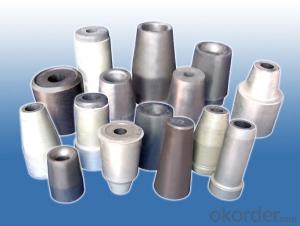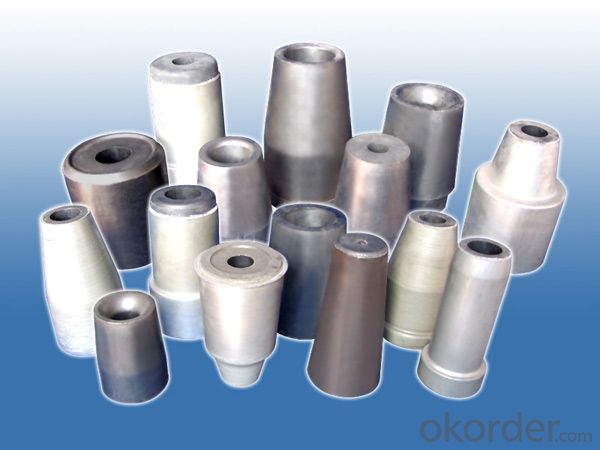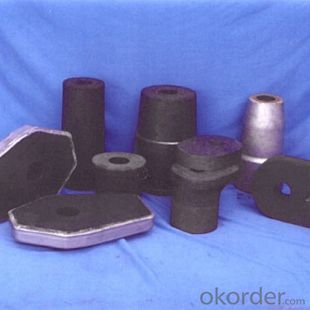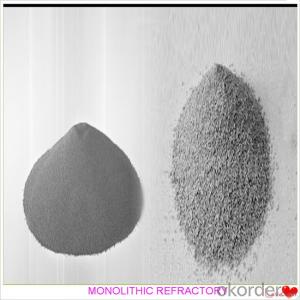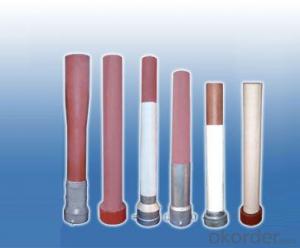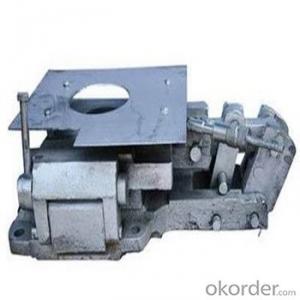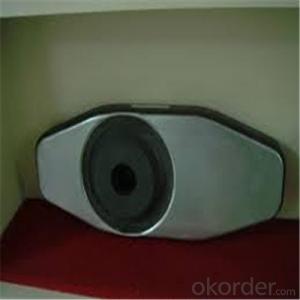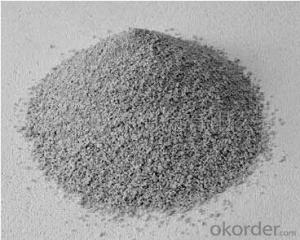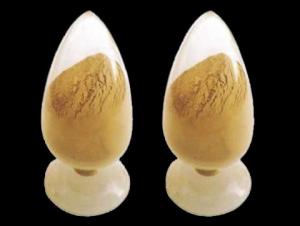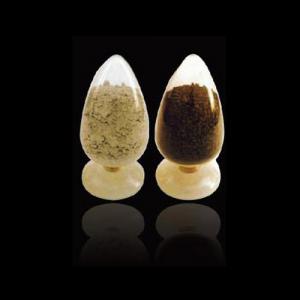Monolithic Refractories Upper & Lower Nozzles for Ladle in Iron and Steel Industry
- Loading Port:
- Shanghai
- Payment Terms:
- TT OR LC
- Min Order Qty:
- 10 set
- Supply Capability:
- 50000 set/month
OKorder Service Pledge
OKorder Financial Service
You Might Also Like
Product Description:
1)High Temperature Burnt Slide Plate
This product adopts tabular alumina, carbonaceous material and zirconia-containing material as main raw materials, adds in high performance antioxidants, uses phenolic resin as binder, formed under high-pressure and burned under high temperature. Mainly used in large and medium-sized ladle.
Physical and chemical properties:
Chemical and Physical Properties | Al-C Slide Gate Plate | Al-Zr-C Slide Gate Plate | ||||||
LQSP-70 | LQSP -75 | LQSP -80 | LQSP -85 | LQSP -86 | LQSP -70 | LQHSP-75 | LQHSP -77 | |
Al2O3,% | 70 | 75 | 80 | 85 | 86 | 70 | 75 | 77 |
C,% | 7 | 7 | 5 | 5 | 4 | 7 | 7 | 7 |
ZrO2,% | - | - | - | - | - | 6 | 6 | 2.5 |
A.P.,% max | 10 | 10 | 10 | 10 | 7 | 10 | 10 | 10 |
B.D.,g/cm3 | 2.8 | 2.9 | 2.9 | 3.0 | 2.95 | 3.00 | 3.05 | 2.90 |
C.C.S., MPa min | 65 | 70 | 100 | 100 | 100 | 110 | 115 | 100 |
2) Low Temperature Burnt Slide Plate
Tabular alumina, zirconia-containing material and spinel as major raw materials, adding in special metal, using phenolic resin as binder, being burned under low temperature during producing process. Mainly used in small and medium-sized ladles.
Physical and chemical properties:
Chemical and Physical Properties | Low Temperature Burnt Slide Gate Plate | ||||
LQLTSP-70 | LQLTSP-75 | LQLTSP-80 | LQLTSP-85 | LQLTSP-86 | |
Al2O3,% min | 70 | 75 | 80 | 85 | 86 |
C,% | ≥5 | ≥5 | ≥5 | ≥4 | 4 |
A.P.,% max | 10 | 10 | 10 | 8 | 7 |
B.D.,g/cm | 2.9 | 2.95 | 3.00 | 3.10 | 2.95 |
C.C.S., MPa ≥ | 90 | 90 | 100 | 120 | 100 |
3) Unburned Slide Plate
Without being burned, tar impregnated and distilled, simple processing. Mainly used in small and medium-sized ladles.
Physical and chemical properties:
Chemical and Physical Properties | Al-C Slide Gate Plate | ||||
LQUSP-70 | LQUSP-75 | LQUSP-80 | LQUSP-85 | LQUSP-86 | |
Al2O3,% | 70 | 75 | 80 | 85 | 86 |
C,% | 7 | 7 | 5 | 5 | 4 |
A.P.,% max | 10 | 10 | 8 | 10 | 7 |
B.D. g/cm3 min | 2.8 | 2.9 | 3.0 | 3.0 | 2.95 |
C.C.S., MPa min | 65 | 70 | 100 | 100 | 100 |
- Q: How do monolithic refractories prevent heat loss through convection?
- Monolithic refractories effectively prevent heat loss through convection due to their unique composition and structure. Unlike traditional refractory bricks, which often have gaps and are porous, monolithic refractories are made of a single, seamless structure. This eliminates any possible pathways for hot gases or air to circulate and carry away heat by convection. Furthermore, monolithic refractories have a high thermal conductivity and are often dense, making them excellent conductors of heat. This allows them to rapidly absorb and distribute heat, minimizing the temperature difference between the hot surface and the surrounding environment. By reducing the temperature gradient, monolithic refractories decrease the driving force for convection, resulting in reduced heat loss through this mechanism. Moreover, monolithic refractories can be applied as a continuous lining, conforming to the shape of the equipment or furnace being protected. This seamless application eliminates joints or gaps where hot gases or air could escape and carry away heat. The uniform and uninterrupted lining further decreases the potential for convection heat loss. In summary, monolithic refractories are specifically designed to create a barrier that hinders the movement of hot gases or air, effectively minimizing heat loss through convection. Their dense composition, high thermal conductivity, and seamless application all contribute to their effectiveness in preventing heat loss through this mechanism.
- Q: How do monolithic refractories resist high temperatures?
- Monolithic refractories, with their unique composition and structure, are specifically designed to withstand high temperatures. Unlike traditional refractory bricks, which are made up of multiple pieces, these refractories are created from a single material or piece. The primary factor contributing to the high temperature resistance of monolithic refractories is their elevated melting point. Materials such as alumina, silica, and magnesia, which have melting points ranging from 1650°C to 2000°C, are utilized in their production. This characteristic allows the refractories to endure extreme temperatures without experiencing significant deformation or melting. Moreover, monolithic refractories possess exceptional thermal stability. They exhibit low thermal conductivity, enabling them to effectively insulate against heat transfer. As a result, these refractories can maintain their structural integrity even when exposed to rapid temperature changes or thermal shocks. Furthermore, the monolithic nature of these refractories grants them enhanced resistance to thermal stress. Unlike traditional refractory bricks, they lack joints or seams that are susceptible to thermal expansion and contraction. Consequently, they exhibit greater resistance to cracking or spalling when subjected to high temperatures. Additionally, monolithic refractories have the ability to develop a protective layer or slag on their surface when exposed to elevated temperatures. This slag acts as a barrier, preventing direct contact between the refractory material and the hot gases or molten metals. Consequently, the risk of chemical reactions or corrosion is reduced. In conclusion, the combination of high melting point, thermal stability, resistance to thermal stress, and the capacity to form a protective slag makes monolithic refractories highly effective in withstanding high temperatures. They find wide applications in various industries, including steel, cement, glass, and petrochemical, where they encounter extreme heat conditions.
- Q: How can the lifespan of monolithic refractories be extended?
- The lifespan of monolithic refractories can be extended through proper installation techniques, regular maintenance, and careful handling.
- Q: What are the common failure mechanisms of monolithic refractories?
- Common failure mechanisms of monolithic refractories include thermal spalling, chemical attack, erosion, and mechanical stress. Thermal spalling occurs when the refractory material is exposed to rapid temperature changes, leading to the cracking and breaking of the refractory lining. This can happen due to thermal shock, such as when a cold material is suddenly exposed to high temperatures, or when the refractory is subjected to cyclic heating and cooling. Chemical attack occurs when the refractory material comes into contact with aggressive chemicals or gases that can react with and degrade the refractory lining. This can lead to the formation of new compounds or the dissolution of the refractory material, weakening its structure and reducing its resistance to further chemical attack. Erosion is another common failure mechanism, especially in applications where the refractory lining is exposed to high-velocity gas or liquid flows. The abrasive action of the flowing medium can gradually wear away the refractory material, leading to thinning and eventual failure of the lining. Mechanical stress, such as thermal expansion or contraction mismatch, can also cause failure in monolithic refractories. When the refractory material is subjected to rapid temperature changes, differential expansion or contraction can occur, leading to the development of cracks and fractures in the lining. To mitigate these failure mechanisms, various techniques can be employed, such as proper material selection based on the specific operating conditions, careful design to minimize thermal gradients, use of protective coatings, and regular inspection and maintenance to identify and address any signs of failure or degradation.
- Q: How do monolithic refractories improve the thermal efficiency of iron and steel furnaces?
- The thermal efficiency of iron and steel furnaces greatly benefits from the use of monolithic refractories. These refractories, which are solid and unified, are essential for lining the furnaces and protecting them from the extreme temperatures involved in the metal production process. One way in which monolithic refractories enhance thermal efficiency is by minimizing heat loss. Due to their low thermal conductivity, these materials do not conduct heat well. By lining the furnace with monolithic refractories, the heat produced inside the chamber is effectively contained, resulting in less heat being lost to the surroundings. This allows for a more efficient use of energy, as less heat goes to waste and more is utilized for the purpose of heating and melting the metal. Moreover, monolithic refractories also contribute to the overall efficiency of iron and steel furnaces by offering a high level of heat resistance. The extreme temperatures experienced inside these furnaces can easily damage traditional refractory materials. However, monolithic refractories are specifically designed to withstand these harsh conditions, maintaining their integrity and performance over long periods of time. This durability ensures that the lining remains intact, preventing any potential leakage of heat and allowing the furnace to operate at its maximum efficiency. Furthermore, the installation process of monolithic refractories is flexible. They can be easily shaped and molded to fit the intricate designs and contours of the furnace, resulting in a seamless and continuous lining. This eliminates any gaps or weak points that could allow heat to escape or cold air to enter, further enhancing the thermal efficiency of the furnace. In conclusion, monolithic refractories significantly improve the thermal efficiency of iron and steel furnaces by reducing heat loss, providing high heat resistance, and ensuring a tight and continuous lining. By optimizing heat utilization and minimizing energy wastage, these refractories play a crucial role in enhancing the productivity and sustainability of the iron and steel industry.
- Q: How do monolithic refractories contribute to the reduction of heat loss in ladles and tundishes?
- Monolithic refractories contribute to the reduction of heat loss in ladles and tundishes by providing a continuous and seamless lining that minimizes thermal bridging and heat transfer. Unlike traditional brick refractories, monolithic refractories eliminate joints and gaps, preventing heat from escaping through these openings. Additionally, their high thermal conductivity and insulation properties ensure efficient heat containment within the ladles and tundishes, reducing energy loss and improving overall thermal performance.
- Q: What are the key properties and characteristics of monolithic refractories?
- Monolithic refractories are a type of refractory material that is manufactured in a single piece or mass, unlike traditional refractory bricks or shapes. The key properties and characteristics of monolithic refractories include their high heat resistance, excellent thermal conductivity, and ability to withstand extreme temperatures and thermal shocks. They also have good chemical resistance, which makes them suitable for use in various industrial applications. Additionally, monolithic refractories offer ease of installation and repair due to their flexibility and ability to conform to different shapes and structures.
- Q: What are the advantages of using low-moisture castables in the iron and steel industry?
- Low-moisture castables offer numerous benefits to the iron and steel industry. Firstly, their lower water content results in shorter drying times, which is crucial in this fast-paced industry. This reduction in overall production time allows for quicker turnaround and increased efficiency. Secondly, low-moisture castables exhibit superior strength and durability when compared to traditional castables. They can withstand extreme temperatures and harsh environments without cracking or breaking. This resilience is essential in an industry marked by high heat and abrasion, ensuring that the castables maintain their structural integrity and endure demanding conditions. Additionally, low-moisture castables boast excellent thermal shock resistance. This means they can handle rapid temperature changes without experiencing cracks or spalling. In an industry that frequently relies on heating and cooling processes, this attribute is highly advantageous. Moreover, low-moisture castables possess a higher density than traditional castables, resulting in improved insulation properties and lower thermal conductivity. This insulation efficiency conserves energy and minimizes heat loss during various processes, ultimately leading to significant cost savings. Lastly, low-moisture castables offer versatility in their application. They can be utilized for various purposes in the iron and steel industry, serving as linings for ladles, furnaces, tundishes, and other high-temperature equipment. This versatility allows for greater flexibility in designing and constructing the necessary infrastructure for iron and steel production. In conclusion, the utilization of low-moisture castables in the iron and steel industry provides a range of advantages, including reduced drying time, increased strength and durability, enhanced thermal shock resistance, improved insulation properties, and versatile application possibilities. These benefits contribute to more efficient and cost-effective operations in this industry.
- Q: How does the choice of monolithic refractory impact the overall cost of iron and steel production?
- The overall cost of iron and steel production can be greatly affected by the choice of monolithic refractory. Monolithic refractory, unlike traditional brick or tile refractories, refers to a type of refractory material that is installed continuously. One important factor that impacts the cost of iron and steel production is the lifespan of the refractory. Monolithic refractories generally have a longer lifespan compared to traditional brick or tile refractories. This means that they require less frequent maintenance and replacement, resulting in lower overall costs over time. Additionally, monolithic refractories have a higher resistance to thermal shock and mechanical stress, which further extends their lifespan and reduces the need for repairs and replacements. Another crucial consideration is the energy efficiency of the monolithic refractory. These refractories possess better insulation properties, leading to reduced heat loss during the iron and steel production process. This helps lower energy consumption and, consequently, the overall cost of production. The improved insulation also contributes to a more stable and controlled temperature profile within the furnace, resulting in better product quality and reduced scrap rates. Furthermore, monolithic refractories offer greater flexibility in terms of installation and repair. They can be easily applied to complex shapes and structures, allowing for more efficient use of refractory materials. This reduces waste and lowers material costs. The ease of installation also saves time and labor, further contributing to cost savings. Additionally, monolithic refractories are known for their superior performance in high-temperature environments. They exhibit excellent thermal conductivity and resistance to chemical attacks, ensuring optimal furnace operation and reducing the likelihood of downtime and production delays. This, in turn, minimizes the impact of unexpected maintenance, repairs, and shutdowns on the overall cost of iron and steel production. In conclusion, the choice of monolithic refractory has a significant impact on the overall cost of iron and steel production. Its longer lifespan, improved energy efficiency, ease of installation and repair, and superior performance in high-temperature environments all contribute to cost savings in various aspects of the production process. Thus, careful consideration of the type of monolithic refractory used can result in significant cost reductions and improved overall efficiency in iron and steel production.
- Q: What are the specific requirements of monolithic refractories for soaking pit applications?
- The specific requirements of monolithic refractories for soaking pit applications are primarily aimed at withstanding high temperatures and thermal cycling, as well as providing excellent resistance to chemical attacks and mechanical stresses. Firstly, monolithic refractories used in soaking pits need to have a high temperature resistance capability, as these pits are subjected to extreme heat conditions. They should be able to withstand continuous exposure to temperatures exceeding 1500 degrees Celsius without any significant degradation. This is crucial to ensure the longevity and durability of the refractories. Secondly, thermal cycling is a common occurrence in soaking pit applications. The refractories should possess good thermal shock resistance to handle rapid changes in temperature. This prevents cracking and spalling, which can compromise the integrity of the refractories. Chemical attacks are also a concern in soaking pit applications due to the presence of molten metal, slag, and other corrosive substances. The refractories used should have excellent chemical resistance to prevent erosion and chemical reactions. They should be able to resist the corrosive effect of molten metal and slag, as well as any potential chemical reactions with these substances. Furthermore, soaking pits involve mechanical stresses, such as abrasion and impact, due to the handling and movement of metal ingots. The monolithic refractories must have good mechanical strength and abrasion resistance to withstand these stresses. They should be able to resist wear and tear caused by the movement of heavy loads and prevent any mechanical failure. Lastly, the refractories used in soaking pits should have good workability and ease of installation. This allows for efficient and effective lining of the pit, ensuring a proper seal and minimizing any gaps or cracks that could lead to heat loss or chemical penetration. Overall, the specific requirements of monolithic refractories for soaking pit applications revolve around high temperature resistance, thermal shock resistance, chemical resistance, mechanical strength, and ease of installation. Meeting these requirements ensures the refractories can withstand the harsh conditions of soaking pits and maintain their performance and integrity over an extended period.
Send your message to us
Monolithic Refractories Upper & Lower Nozzles for Ladle in Iron and Steel Industry
- Loading Port:
- Shanghai
- Payment Terms:
- TT OR LC
- Min Order Qty:
- 10 set
- Supply Capability:
- 50000 set/month
OKorder Service Pledge
OKorder Financial Service
Similar products
Hot products
Hot Searches
Related keywords
